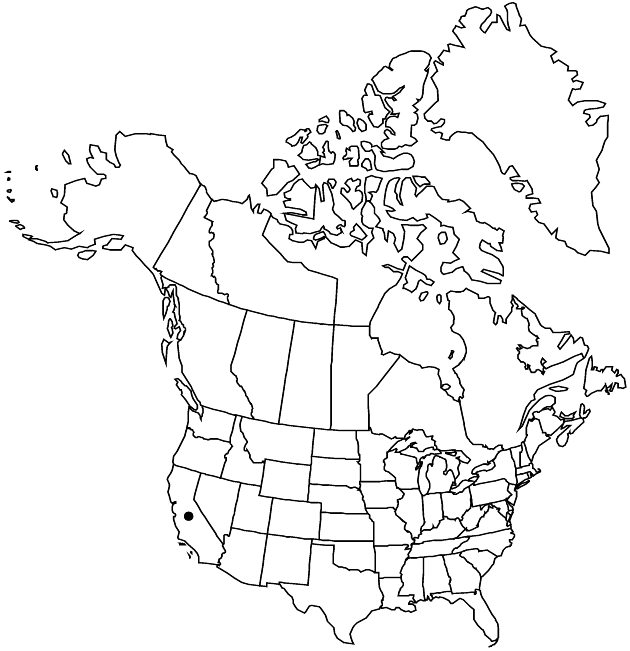Difference between revisions of "Chaenactis glabriuscula var. glabriuscula"
FNA>Volume Importer |
FNA>Volume Importer |
||
| Line 28: | Line 28: | ||
|elevation=100–2300 m | |elevation=100–2300 m | ||
|distribution=Calif.;Mexico (Baja California). | |distribution=Calif.;Mexico (Baja California). | ||
| − | |discussion=<p>Variety glabriuscula is known mainly in and west of the Peninsular Ranges and adjacent desert edges, inland from the coast; it also extends to Santa <i>Rosa</i> Island. Northward it intergrades with vars. megacephala and lanosa; near the coast it intergrades with <i></i>var.<i> orcuttiana</i>. Forms sometimes recognized as <i></i>var.<i> tenuifolia</i> are distinctive in the filiform leaf segments but merge seamlessly with the remainder of <i></i>var.<i> glabriuscula</i>.</p> | + | |discussion=<p>Variety glabriuscula is known mainly in and west of the Peninsular Ranges and adjacent desert edges, inland from the coast; it also extends to Santa <i>Rosa</i> Island. Northward it intergrades with vars. megacephala and lanosa; near the coast it intergrades with <i></i></i>var.<i><i> orcuttiana</i>. Forms sometimes recognized as <i></i></i>var.<i><i> tenuifolia</i> are distinctive in the filiform leaf segments but merge seamlessly with the remainder of <i></i></i>var.<i><i> glabriuscula</i>.</p> |
|tables= | |tables= | ||
|references= | |references= | ||
| Line 52: | Line 52: | ||
|publication year= | |publication year= | ||
|special status= | |special status= | ||
| − | |source xml=https://jpend@bitbucket.org/aafc-mbb/fna-data-curation.git/src/ | + | |source xml=https://jpend@bitbucket.org/aafc-mbb/fna-data-curation.git/src/f6b125a955440c0872999024f038d74684f65921/coarse_grained_fna_xml/V19-20-21/V21_1035.xml |
|tribe=Asteraceae tribe Heliantheae | |tribe=Asteraceae tribe Heliantheae | ||
|subtribe=Asteraceae (tribe Heliantheae) subtribe Chaenactidinae | |subtribe=Asteraceae (tribe Heliantheae) subtribe Chaenactidinae | ||
Revision as of 18:45, 24 September 2019
Plants 10–60 cm; proximal indument grayish, ± arachnoid. Stems mostly 1–5, ascending to erect; branches proximal and, often, distal. Leaves basal (withering) and cauline, 3–8 cm; largest blades ± plane to 3-dimensional, scarcely succulent, 1(–2)-pinnately lobed; primary lobes 2–7 pairs, remote to ± congested, ultimate lobes plane, twisted, involute, or terete. Heads 2–20+ per stem. Peduncles 1–4(–10) cm. Involucres ± hemispheric to obconic. Phyllaries: longest 5–7 × 1–2 mm; outer (at least medially) ± arachnoid-sericeous and, often, ± stipitate-glandular in fruit. Florets: inner corollas 4–6 mm. Cypselae 3–5.5 mm; pappi of (1–)4 scales in 1 series, longest scales mostly 2–4 mm, lengths 0.4–0.7 times corollas. 2n = 12.
Phenology: Flowering Feb–Jun.
Habitat: Dry slopes, sandy places, openings in chaparral, woodlands
Elevation: 100–2300 m
Distribution

Calif., Mexico (Baja California).
Discussion
Variety glabriuscula is known mainly in and west of the Peninsular Ranges and adjacent desert edges, inland from the coast; it also extends to Santa Rosa Island. Northward it intergrades with vars. megacephala and lanosa; near the coast it intergrades with var. orcuttiana. Forms sometimes recognized as var. tenuifolia are distinctive in the filiform leaf segments but merge seamlessly with the remainder of var. glabriuscula.
Selected References
None.